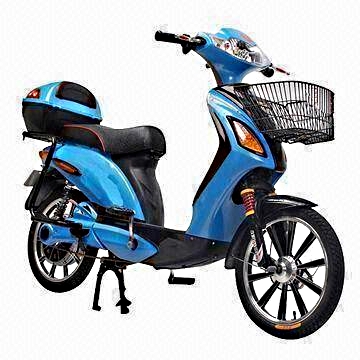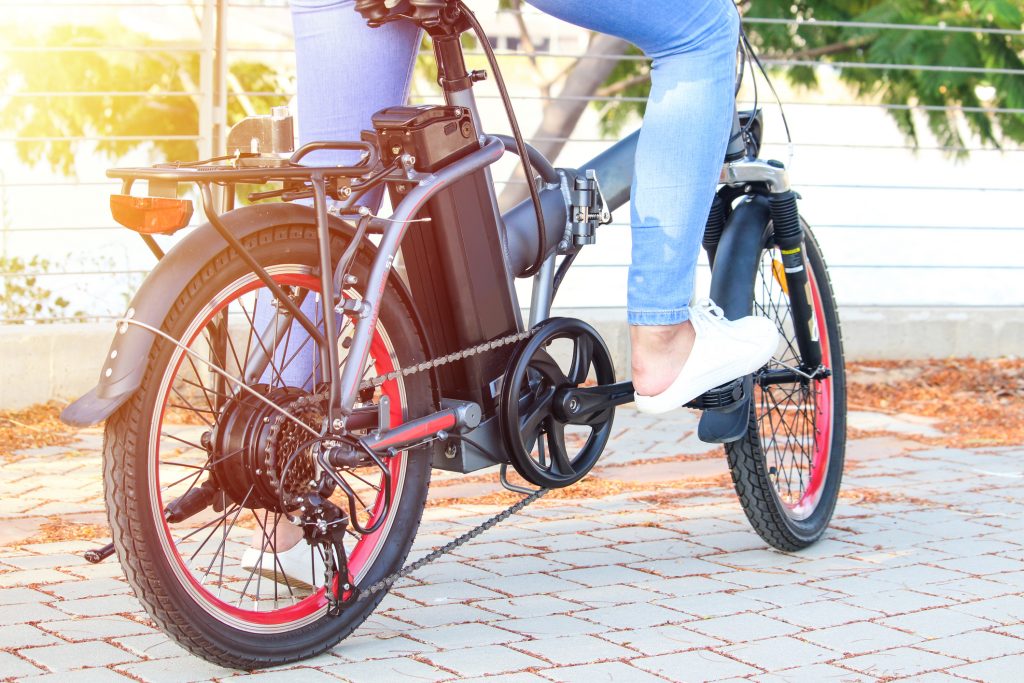Now here’s a subject that tends to be more controversial than oil choices for a motorcycle or what type of tire to use – namely E-bikes. They’re not quite a bicycle, not quite a motorcycle, and not quite a moped.
Some people see them as a cheap transportation method within cities, low maintenance and environmentally friendly.

Others see them as riders who have little or no training, little understanding of the laws that apply to them, and a hazard that’s too either too fast for the bike lanes and sidewalks, or too slow for many of the roads they end up riding on.
The real answer I suspect is somewhere in the middle, and depends on the circumstances. But before we get into that… let’s start off this look at the electric bicycle with a simple question.
What is an E-Bike?
Many of the basic questions of the legal definition of what are the laws in Ontario regarding E-Bikes can be found at the MTO FAQ here. You can also find the Ontario regulations on E-bikes here. You can find the definition of “Power Assisted Bicycle” in the Canada Motor Vehicle Safety Regulations here. (Scroll down to “Power-assisted bicycle”.)
An E-Bike (as defined by the Ontario Ministry of Transportation and our Highway Traffic Act) is an Electric Bicycle. It must have the following characteristics.
- An E-Bike must have functional pedals attached to the bike.
- An E-Bike must be 120KG or less (including weight of bike and battery.)
- All operators must be at least 16 years of age.
- All operators must wear an approved bicycle or motorcycle helmet.
- The minimum wheel diameter is 350mm, and the minimum wheel width is 35mm.
- There must be no modifications to the motor to allow it to exceed a power output greater than 500w and a speed greater than 32 km/h.
- Interestingly, though they do not require a license to operate, if your license is suspended due to a conviction that has resulted in a driving prohibition under the Criminal Code of Canada, you cannot legally operate an E-bike.
- The E-bike must have a permanent label from the manufacturer in both English and French stating that your E-bike conforms to the federal definition of a power-assisted bicycle.
- You cannot ride an E-bike on certain Provincial controlled access highways (such as the 400 series… though I suspect any such ride would be brief and um…. traumatic.)
- You cannot ride an E-bike on roads, including sidewalks where bicycles are banned under municpal by-laws or on roads sidewalks or bike paths where E-bikes are prohibited. (We’ll talk more about this later.)
It’s important to know the rules as to what an E-bike is, according to the Ministry of Transportation – because if it isn’t legally an E-bike and an officer who is aware of the law finds you riding on a public road what you may be charged with is riding an unregistered, uninsured motor vehicle. And that’s something that could get expensive fast, with fines for driving without insurance alone starting at $5000 and going up fast from there.
And that could happen by simply removing the pedals.
It’s something a lot of people are not aware of – I see electric motorcycles and scooters that clearly have *never* had pedals advertised for sale in buy and sell sites and listed being as “E-bikes” and not needing insurance.
I’ve seen people talking about how to get more speed out of their E-bikes on internet forums, without realizing that again if they get caught – they are no longer on an E-bike by provincial and federal law. If you exceed the max speed or power, it simply isn’t under the E-bike definition and then it just is an unregistered motor vehicle.
Now you might get away with this for a while – it seems E-bike regulations aren’t something many officers are familiar with and I’ve even had a by-law office in a small town asking Scoottoronto for advice on a situation they were dealing with – but all it takes is one officer catching on and you’re in for a world of financial hurt. (All this being said, I’m not a lawyer, this is not legal advice, but if you take a look a the regulations they are pretty clear and you should be very cautious before listening to anyone who tells you otherwise – be they a seller or an “internet expert” on a forum. It’s a big risk.)
When were E-bikes allowed in Ontario?
The Ontario Government launched a 3 year pilot program on October 4th, 2006 to evaluate where e-bikes could be safely integrated on Ontario roads. This meant for the first time ever in Ontario, E-bikes were allowed in places where regular bicycles were.
Do any Municipalities prohibit E-bikes?
Yes, depending on the municipality and the place you are riding.
Toronto bans all bicycles – including E-bikes – on sidewalks. Rarely enforced in my experience but it’s a $60 dollar fine.
There are several other rules in Toronto (the full list is HERE) including (these are direct quotes from the toronto.ca FAQ page):
“E-bikes are treated like bicycles in Toronto only if they are pedal-assisted or “pedelecs” and require pedalling for propulsion (i.e., the power is cut to the motor when the rider stops pedalling). Such pedal-assisted e-bikes can be used on roads and all types of cycling infrastructure: painted bike lanes, cycle tracks (separated bike lanes), and multi-use trails or paths in parks.”
“Power-assisted e-bikes are e-bikes that are capable of operating solely by motor power and are only allowed on roads and on painted bike lanes.
Power-assisted e-bikes may be bicycle-style, scooter-style or moped-style – and regardless of style of appearance, they do not require any muscular power or pedalling for propulsion.
“Power-assisted e-bikes are not allowed on cycle tracks (separated bike lanes) or multi-use trails or paths. Such power-assisted devices pose safety risks when mixing with slower, human-powered modes like bicycles, skateboarders, or kick-scooters (without throttle). It is also difficult and risky for such e-bikes to exit cycle tracks which have raised curbs or vertical elements when passing slower cyclists, whereas painted bike lanes do not present such issues.”
“Motorized vehicles including power-assisted e-bikes may not be used on park multi-use paths. If a motorized vehicle is used on a park path, the rider/driver may be fined by bylaw enforcement officers. The Waterfront Multi-use path, Don Valley & Humber Multi-use paths, are all considered parklands. The new railpath & Hydro corridor trails are considered linear parks.”
Other Municipalities may have their own regulations as to where you can ride an E-bike as well – best to check up before you ride. (This shouldn’t often be an issue, as most E-bike riders aren’t going to be hopping from city to city.)
And now we get to the Opinion part….
Ok – so we’ve discussed the state (as of today, November 6th 2020…. since laws are subject to change) of the laws involving E-Bikes in Ontario.
Which brings us to the question that is entirely opinion based…. are E-bikes a *good* thing?
For this, I’d have to break down E-bikes into two types, “Scooter” styled where they have full bodywork and are often styled to look like a small 50cc scooter, and “Bicycle” styled E-bikes such where the motor adds a little bit of electrical help as the rider pedals.

The “Scooter” styled ones are physically larger, wider and heavier – which any two wheeled rider knows isn’t something that will improve handling or braking. The pedals that are on them (at least occasionally removed by the rider, despite being a legal requirement) are set in such a way that it would be challenging to pedal more than a handful of meters, and they stick out well to the side as compared to a standard bicycle.
Being wider – they take up more of the road and more of the bike paths (if your municipality permits them on the bike path at all) – meaning the machine is closer to vehicles passing by – and at 32kph max speed, if you are on a public road vehicles *will* be passing you.
Even at 32kph they have enough speed to cause damage to the rider and people around them – yet they have no training required, no insurance, and you can wear a bicycle helmet which offers limited head protection.
These are not safe in my opinion. Some riders, in some towns, with limited speed roads with low traffic – it *might* be safe. Other places I think it is a risk for both pedestrians and the riders.
Don’t get me wrong – I’m all for electric motorcycles. If you had something that could go similar speeds to 50cc scooter – say 60kph – and had a basic license and cheap insurance I’d be all for it. But at least give them a minimum of training, enough speed to keep up with traffic on a 50kph municipal road, and insurance to cover both rider and pedestrians in an accident.
That being said, I have less reservations about a “bicycle” or power *assisted* E-bike. One which assists you pedaling but otherwise operates more like a regular bicycle. These are lighter, narrower, and in general operate like an ordinary bicycle – just easier.

I think these were what the government had in mind when “E-bikes” first had their trial period on Ontario roads, not the much larger plastic fairing’d scooter style machines.
So where does that leave us?
I think realistically, E-bikes are here to stay. There’s just too many of them to yank them off the road. But I think where we might run into problems is the future of Electric Motorcycles becoming more popular.
Guaranteed (I’ve already seen it in marketplace listings online) you will get people selling EV motorcycles styled like scooters as “E-bikes” without them actually being road legal, either as an electric motorcycle or as an E-bike.
As more of them get onto the road – you’re going to have law enforcement become more aware of them – which will mean people will be in for a very rude surprise when they get a massive ticket and the machine possibly confiscated.
The confusion may even cause some problems for legitimate Electric Motorcycle dealers when they eventually start selling – their machines being mistaken for “e-bikes” even if plated and legally on the road. (Though I’m speculating on that, it’s hard to tell.)
Right now – in terms of sellers claims as to what is legal and the way people ride them – we’re in a bit of the wild west. With riders heading out without training, proper gear, or an awareness of basic road safety.
We’ve accepted that for bicycles for some time – but I’m just not sure it’s a good idea to apply the same practice for something that is designed in such a way as to make it almost impossible to actually pedal for any distance. At that point it’s just not a bicycle.

And if it’s not a bicycle – should it legally be an E-bike? That’s a question I think that will evolve over the next while. We all know electric two wheelers are just going to get more common.
It’s just how many forms of them we will have, and the laws that will effect them that might well change.
